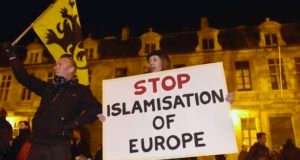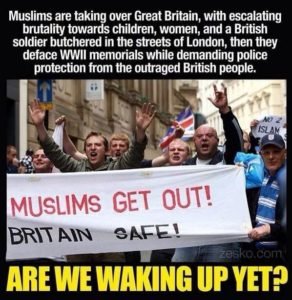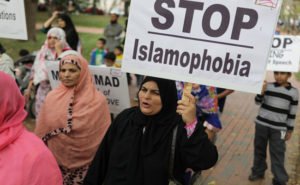Historical Essay: The Rise of Islamophobia in Europe
This is an academic historical essay that was presented in our major class. This paper tackles a sensitive yet timely issue surrounding he European region. I hope you'll learn something out of it.
INTRODUCTION

Source
Islam is the second largest religious belief in Europe. Muslim communities, though a minority, has existed in Europe as early as the Umayyad Dynasty and was reinforced by later successors, most especially during the Ottoman conquests in the late middle ages. These Muslimsare greatly diverse with varied histories and origins. However, the Europe today is facing an issue regarding the increasing Muslim populace in the region. The Europeans, particularly the majority non-Muslims, are alarmed to the tremendous influx of the Muslims, which the former considered strange for their place. What actually caused this recent feeling of unusualness to the European origins is the continuing immigration of Muslims coming from some chaotic parts of the Middle East.
The first entry of substantial number of Muslim immigrants in Europe was in the late twentieth and early twenty-first centuries. A demographic study by Pew Research Center shows that Muslim migrants to Europe even increased thesepast few years. It states that:
“The number of Muslims in Europe has grown from 29.6 million in 1990 to 44.1 million in 2010….From 1990 to 2010, the number of Muslims in Europe increased by about 14.5 million.”
In addition, the later studies of Pew Research Center revealed that:
“Altogether, a slim majority of all migrants to Europe – both refugees and regular migrants – between mid-2010 and mid-2016 (an estimated 53%) were Muslim. In total number, roughly 3.7 million Muslims and 3.3 million non-Muslims arrived in Europe during this period.”
Notably, this data presented may still multiply in the future not merely due to the continued migration; but the fact that this populationcan possibly reproduce while they are in Europe.

Source
Having presented the statistics of Muslim immigrants in Europe, it is relevant to recognize that the dramatic growth of the total Muslim population in the continent led to themselves being often the subject of public discussions and political campaigns. Usually, these are revived by events like terror attacks in which a Muslim was involved, debates over Islamic dress, and others. These events fuelled the growing issue of Islamophobia and attitudes toward Muslims.
THE EUROPEAN MIGRANT CRISIS AND MUSLIMS

Source
MEMBERS OF THE BELGIAN BRANCH OF GERMANY'S ANTI-ISLAM GROUP, PEGIDA (PATRIOTIC EUROPEANS AGAINST THE ISLAMISATION OF THE WEST), TAKE PART IN A DEMONSTRATION IN ANTWERP, MARCH 2, 2015. GERMANY HAS EXPERIENCED AN UPSURGE OF ANTI-ISLAM SENTIMENT IN THE FORM OF WEEKLY PEGIDA PROTESTS IN DRESDEN.
With the increasing number of refugees from war-torn and economically shattered Arab countries in Europe, it has turned into a central issue of public discourse. In 2015, more than one million migrants entered the European continent, which was accordingly more than twice the number as in the previous year. Due to this sudden influx of immigrants in Europe, who despite the risks, travelled to Europe by crossing the Mediterranean Sea and then continued their way to other European states (which are landlocked countries within the continent), it was called the European migrant crisis.
It is essential to stress out that most of these people came from the Middle East, and there are some from South Asia and Africa. The political upheavals in the Middle East, Africa, and South Asia are drastically affecting the migration trends in Europe. Based on the records, the number of illegal border-crossing detections in the EU started to surge in 2011, as thousands of Tunisians started to arrive at the Italian island of Lampedusa following the onset of the Arab Spring. Sub-Saharan Africans who had previously migrated to Libya followed in 2011–2012, fleeing unrest in the post-Qaddafi era. But, the most recent surge in detections along the EU’s maritime borders has been attributed to the growing numbers of Syrian, Afghan, and Iraqi migrants. Syrians fleeing their country’s long period of civil war made up the largest group, and Afghanstrying to escape the war with Taliban rebels made up thelargest groups of Muslim migrants, respectively. Moreover, the deteriorating security and grinding poverty in Iraq have also contributed to the migrant influx. As observed, the origins of these people were Muslim-countries. Hence, it follows that though there are non-Muslim migrants, most of them are Muslims.
DEFINITION & HISTORY OF “ISLAMOPHOBIA”
Gottschalk and Greenberg defined Islamophobia as a social anxiety toward Islam and Muslim cultures that is largely unexamined by, yet deeply ingrained in, especially among the Westerners. This phobia, as discussed on their book, is a result for most from distant experiences that mainstream Western culture has perpetuated in popular memory, which are in turn buttressed by a similar understanding of current events. Hence, this anxiety relies on a sense of otherness, despite many common sources of thought. Moreover, the two authors also pointed out the Western idea of islamophobia, equating Islam to Middle East, Muslim men to violence, and Muslim women to oppression; that could be traced back to the history as old as Islam itself, which is the confrontation between the overwhelmingly Christian Europe and the predominantly Muslim Middle East over economic resources, political power and religious sites. So, as this competition persisted, Europeans came to negatively portray Muslims so effectively and so universally that the terms “Islam” and “Muslim” have come to inherently evoke suspicion and fear on the part of many.
Meanwhile, according to Naved Bakali on his book entitled Islamophobia: Understanding Anti-Muslim Racism Through The Lived Experiences, islamophobia is relatively a new termwhich draws its etymological roots from Europe in the early 12th century. Based on the record, the earliest found usage of this term could be traced back to France in 1925 by authors Etienne Dinet and Slima Ben Ibrahim on their writings entitled Accès De DélireIslamophobe (Islamophobic Delirium), which refers to the Western perceptions of Muslims. Similar to Gottschalk and Greenberg, Bakali also emphasized that fear and mistrust towards Muslims and being perceived as a dramatically opposed “other” have deeper roots in Europe. He noted Paul Weller’s remarks which says that “islamophobia is undeniably rooted in the historical inheritance of a conflictual relationship that has developed over many centuries involving the overlap of religion, politics and warfare.”
THE RISE OF ISLAMOPHOBIA IN EUROPE

Source
It is almost inconceivable that at the turn of twenty first century both the term and concept of Islamophobia had little discursive resonance or value across most of Europe. Today, however, the same could be no further from the truth.As Dr. Chris Allens concluded that. . . “Consequently, Islamophobia emerges from a myriad range of sources and settings across Europe. But as we seen in both historiography and in the British context previously, rarely is there any clear thinking or understanding employed as regards usage or understanding.” He further cited the high profile murder of Theo Van Gogh in The Netherlands, and the backlash against Muslims that ensued through “direct democracy”votes against the building of minarets to verbal abuse against Muslim women and children and in various European locations, as innumerable and disparate events and incidents –whether rightly or wrongly – regularly and repeatedly incorporated into the discursive landscape of Islamophobia. Thus, Islamophobia, Dr. Allens added, is at timeslittle more than an indiscriminate and all-encompassing term that is employed to satisfy or appease a vast spectrum of commentators, actors, and perpetrators in varying different ways.
In addition, the spread of Islamophobia is based in part on a conviction of Europe is in peril because of Islamization itself, associated with both the increase in the size of Muslim communities as a result of immigration and also with the culture wars that have followed. Many politicians and observers agree that the growing presence of visible symbols of Islam like the masjids, minarets, headscarves, etc., contributes to the sense of Islamization in Europe. The secularity fears heightened by Muslim terrorist attacks often rest on the assumption of an unbridgeable civilizational divide between Western and Islamic worlds. That is accordingly not least of the stigmas that are attached to Muslims is a racial frame of being of non-European stock. Hence, islamophobia entails a cultural racism that sets Muslims apart. As a result, a Muslim migrant is constructed as someone burdened by alien attributes and as a carrier of antagonistic, threatening values. In this sense, the immigrant becomes not anymore an ordinary outsider, but a terrorist within.
“ISLAMOPHOBIC” EVENTS
Islamophobia, as described, is a complex phenomenon which involved multiple actors with numerous victims. This section about the “Islamophobic” events in Europe refers to the incidents that could have possibly triggered the heightening of Islamophobia in the continent. Prior to the recent attacks in Europe from 2014 to the later incidents, there were four unfamous accounts pointing to some Muslims as its perpetrators.
First is the 2004 Madrid train bombings. This killed 192 people and injured around 2,000.The official investigation by the Spanish judiciary found that the attacks were directed by an al-Qaeda terrorist cell,although no direct al-Qaeda participation has been established.

Source
Later, on November of the same year, it was followed by the assassination of Theo Van Gogh, a Dutch film director. He was assassinated by Mohammed Bouyeri while biking in Amsterdam. Bouyeri despised Van Gogh's work on Islam and shot and stabbed him several times.
That was then followed by 7th July 2005 London bombings. It saw four “Islamic” terrorists separately detonating three bombs in quick succession aboard London Underground trains across the city and, later, a fourth on a double-decker bus in Tavistock Square. The train bombings occurred on the Circle line near Aldgate and at Edgware Road, and on the Piccadilly line near Russell Square. Fifty-two people, all UK residents but of 18 different nationalities, were killed and more than 700 were injured in the attacks, making it Britain's deadliest terrorist incident since the 1988 bombing of Pan Am Flight 103, as well as the country's first ever Islamic suicide attack.
Gapped with several years, it was followed by the March 2012 Toulouse and Montauban shootings consisted of a series of attacks in the South of France perpetrated by “Islamic” terrorist Mohammed Merah. A first attack that occurred on 11 March killed a French Army paratrooper in Toulouse; it was followed by a second attack on 15 March that killed two uniformed French soldiers and seriously injured another in Montauban Shopping Centre. On 19 March, four people, including three children, were killed at the OzarHatorah Jewish day school in Toulouse.
On January 7, 2015, did the attack on Charlie Hebdo offices in Paris happen. The shootings perpetrated by brothers Saїd and ChérifKouachi, resulted in twelve deaths, including some famous French cartoonists Jean Cabut, Stèphane Charbonnier, and Philippe Honoré, and also the death of Muslim police officer Ahmed Merabet.
Another extremist attack occurred still in Paris on November 13, 2015, that resulted in 130 deaths and 368 atrocities. This was claimed by the so-called ISIL. The suspects were speculated to be from Molenbeek area of Brussels. As a result, it gained not just their local but national and international scrutiny of Belgian Muslims and a sharp rise of Islamophobia.
Take note that aside from those mentioned above, there were several attacks, especially in between 2014 to 2015 and even until 2017.
THE CONSEQUENCES OF MUSLIMS IN EUROPE

Source
The terrorist attacks made by some Muslims did not just worsen Islamophobia in Europe but it affected the lives of Muslim minorities living in the continent. There is more visible discrimination against young people in which their Muslim faith is a factor, like in the justice system, double punishment applies to Muslim detainees – that bears the dual stigma of being Muslims and detainees. In school, the general teaching, syllabuses, even just being called Usama.In employment, they got hardships in recruitment and in the workplace. Similarly in housing. In the media, when the news is good, it silenced, but when it is bad, it shifts to denigration. Likewise in politics. In voluntary work, Muslims experienced refusal of subsidies, lack of recognition, refusal of partnerships, association members placed under surveillance.
Concerning the consequences of Islamophobia on young women, women can be an easier target because of their appearance. In fact, the victims of discrimination and racist violence are usually identified as representative of a specific group, in Muslims, according to their skin, facial shape, place of worship or dress, etc. Many Muslim young women choose to wear the hijab and thus, making easily recognized and become, in different ways, victims of Islamophobic acts. Indeed, as reported by the EUCM, after 11thSeptember 2001, “the hijab seems to have become the primary visual identifier as a target for hatred, with Muslim women being routinely abused and attacked across those countries in the eu where Muslim women could be identified in this way”. All over Europe, young Muslim women, are attacked in different ways and, as mentioned before, more frequently after the 11th September. Some experience insults and threats, especially in public places and on public transport. Many girls at schools have been told by their mates “go back to your countries”, label them as “sister of Bin Laden”, “a terrorist”, and even aggressively utter imperatives like “take off that cloth from your head”, etc. Other girls are victims of physical assaults: their headscarf is pulled away; objects like lighters or cans are thrown at them; people spit on them; etc. This kind of attack harms not only the person attacked, but all the other girls in her same situation, as they all tend to feel insecure and unable to enjoy a normal life. Certainly, those consequences above have been true to Muslims with older age.
CONCLUSION
In conclusion, Islamophobia is relatively a new term that upholds the core idea of xenophobia; but what only differs the former from the latter is that it is more specific. Although it is a modern word, it has a long-timehistory that is traced through the conflictual relationship that has been developed between the Middle East and the Europe. Terror attacks in Europe caused not only fear towards Islam and Muslims, but more importantly, a struggle of the minority. These events might have been successful in raising Islamophobia in Europe, but it certainly did not made any advantage towards the Muslims and Islam. The perpetrators, who were told as Muslims, were just few from the rest of Muslims who are innocent from the crime, yet the whole Muslim community suffer the consequences of Islamophobia. Insults may be the lightest, and physical assaults may be the heaviest. Prejudice against Muslims is now widespread in Europe.
BIBLIOGRAPHY
Allens, Dr. Chris. Islamophobia. Birmingham: Ashgate Publishing, 2013.
Bakali, Naved. Islamophobia: Understanding Anti-Muslim Racism Through The Lived Experiences. Canada: Sense Publisher, 2016.
Barlai, Melani., Birte Fähnrich, Christina Griessler and Markus Rhomberg. The Migrant Crisis: European Perspectives and National Discourses. Münster: LIT Verlag, 2017.
Bayrakli, Enes., Hafez, Farid. European Islamophobia Report 2015. Ankara: SETA, 2016.
Center, Pew Research. "Europe's Growing Muslim Population." 2017: 14.
Center, Pew Research. "The Future of Global Muslim Population ." Pew Research Center, 2011: 23-24.
Gottschalk, Peter., Gabriel Greenberg. Islamophobia: Making Muslims the Enemy. Maryland: Rowman & Littlefield, 2008.
Noonan, Norma C., Vidya Nadkami. Challenge and Change: Global Threats and the State in Twenty-first Century International Politics. California: Springer, 2016.
Ramberg, Ingrid. Islamophobia and its consequences on Young People. Hungary: Directorate of Youth and Sport of the Council of Europe, 2004.
Taras, Raymond. Xenophobia and Islamophobia. Edinburgh: Edinburgh University Press, 2012.
Posted from my blog with SteemPress : http://zam398.vornix.blog/2018/07/24/historical-essay-the-rise-of-islamophobia-in-europe/
Wow! I commend you for your hard work zam! Keep it up! Will support you!
Wow. Thank youuu. Welcome back uy. Na busy na guro ka